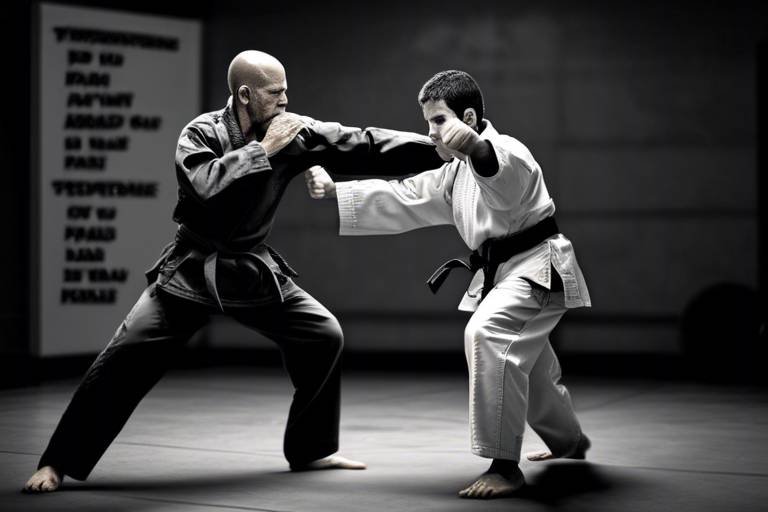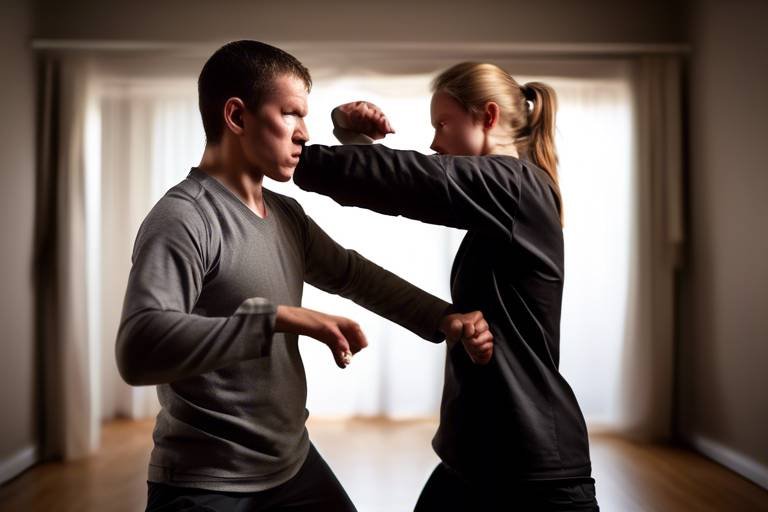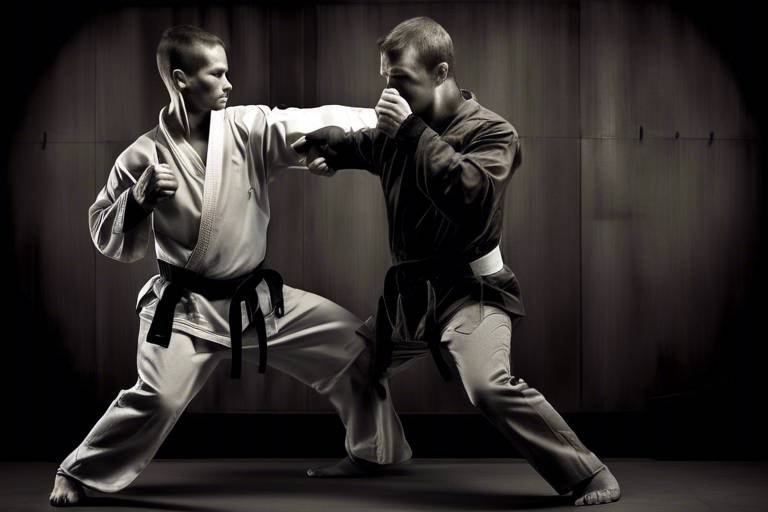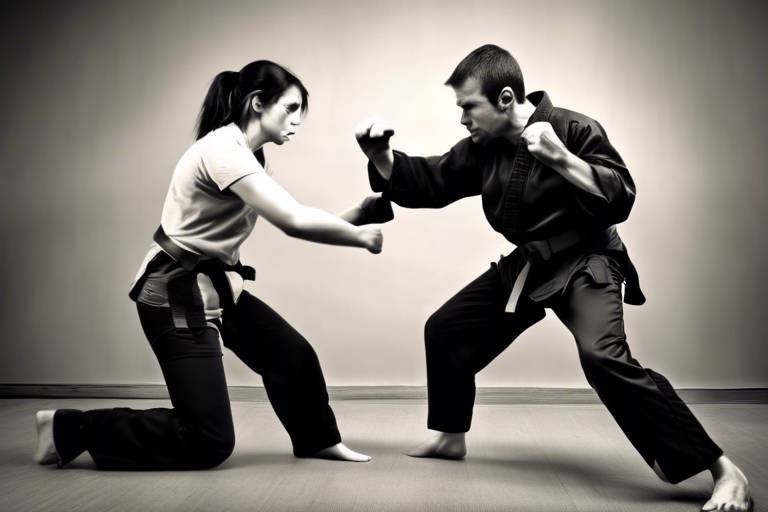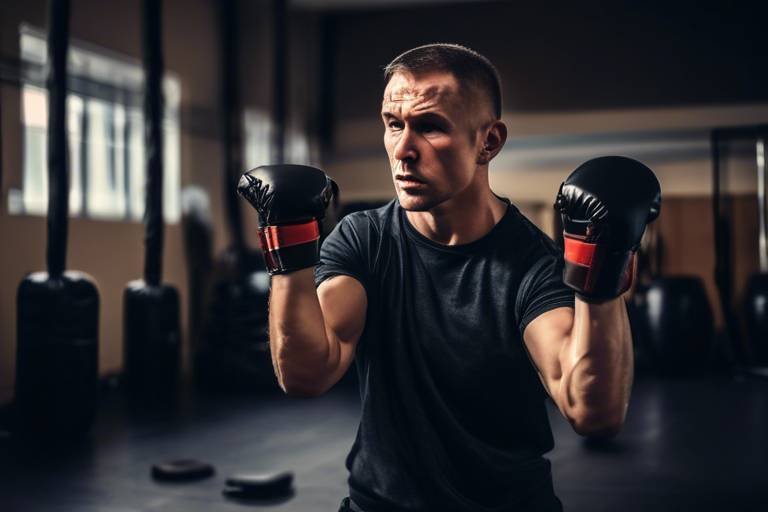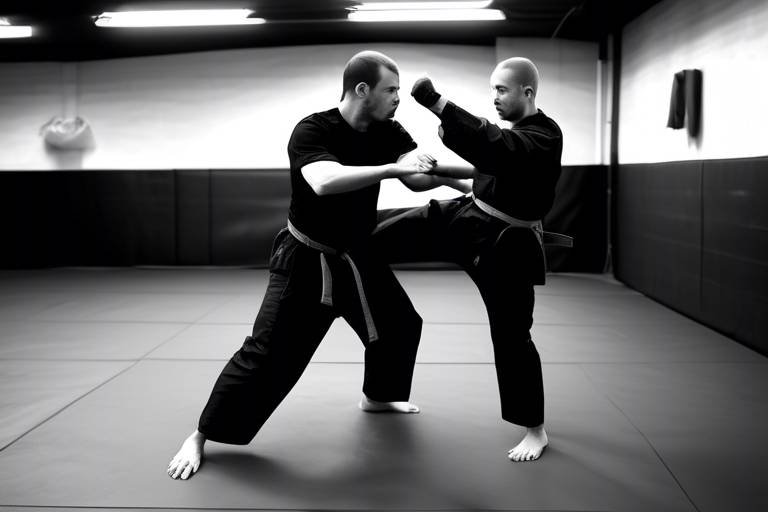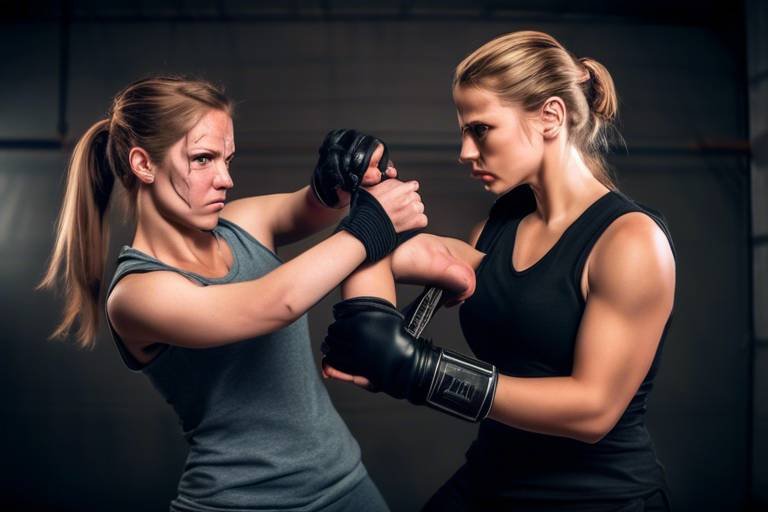Five Key Principles to Remember in Self Defense Training
Self-defense training is not just about learning how to throw a punch or execute a perfect kick; it's about building a comprehensive skill set that empowers you to protect yourself in various situations. In today's world, where unexpected threats can arise at any moment, understanding the five key principles of self-defense training is crucial. These principles not only enhance your physical abilities but also bolster your mental readiness, making you more prepared and confident in the face of danger.
The first principle, the Principle of Awareness, establishes the foundation for all self-defense strategies. Awareness is about being attuned to your surroundings and recognizing potential threats before they escalate. Imagine walking through a crowded street; instead of being glued to your phone, you should be scanning your environment. This proactive approach can prevent dangerous situations from developing and keep you one step ahead of any potential aggressor.
Next, we delve into the Importance of Physical Fitness. It’s no secret that a fit body can react faster and more effectively in emergencies. Regular physical training enhances your strength, agility, and endurance—key components that can determine the outcome of a self-defense situation. Think of your body as a finely tuned machine; the better you maintain it, the more efficiently it will operate when it matters most. By incorporating cardiovascular training, strength training, and flexibility exercises into your routine, you can develop a well-rounded fitness regimen that prepares you for any scenario.
Awareness is the cornerstone of self-defense. By staying vigilant and recognizing potential threats, individuals can avoid dangerous situations before they escalate, fostering a proactive approach to personal safety.
Physical fitness plays a crucial role in self-defense. Maintaining strength, agility, and endurance enhances one’s ability to escape threats and defend effectively, making regular exercise an essential component of training.
Engaging in cardiovascular training boosts stamina and overall fitness, enabling individuals to react swiftly in emergencies. Incorporating activities like running or cycling can significantly improve performance during self-defense scenarios.
Strength training enhances muscle power, which is vital for executing effective self-defense techniques. Incorporating weightlifting or resistance exercises can lead to improved physical capabilities and confidence in confrontational situations.
Flexibility and agility training help improve movement efficiency and reduce injury risks. Practicing stretching and agility drills can enhance one’s ability to maneuver quickly during self-defense encounters.
Consistent practice is essential for mastering self-defense techniques. Regular training sessions help reinforce skills, build muscle memory, and increase confidence in applying techniques under stress.
Knowledge of legal implications surrounding self-defense is vital. Understanding what constitutes justifiable self-defense can help individuals navigate situations without legal repercussions, ensuring their actions are both effective and lawful.
Familiarizing oneself with local self-defense laws is crucial. Each jurisdiction has specific regulations that dictate when and how self-defense can be legally applied, impacting decision-making in real-life scenarios.
Being aware of the potential consequences of using self-defense is essential. Understanding the legal and emotional aftermath of defensive actions can help individuals make informed choices in critical moments.
Mental preparedness is as important as physical training in self-defense. Developing a strong mindset helps individuals remain calm and focused during confrontations, improving their chances of successfully defending themselves.
Visualization techniques can enhance mental preparedness. By mentally rehearsing potential scenarios, individuals can increase their confidence and readiness to respond effectively in real-life situations.
Effective stress management strategies are vital for maintaining composure during high-pressure situations. Techniques such as deep breathing and mindfulness can help individuals stay focused and make better decisions when threatened.
- What is the most important principle in self-defense training? Awareness is considered the cornerstone of effective self-defense.
- How can physical fitness improve my self-defense skills? Physical fitness enhances strength, agility, and endurance, allowing for quicker reactions and better performance during confrontations.
- Are self-defense laws the same everywhere? No, self-defense laws vary by jurisdiction, so it's essential to familiarize yourself with local regulations.
- How often should I practice self-defense techniques? Regular practice is key; aim for at least a few sessions each week to build muscle memory and confidence.

Principle of Awareness
This article explores essential principles that enhance self-defense training effectiveness, ensuring preparedness and confidence in various situations. Understanding these principles can significantly improve personal safety and response capabilities.
Awareness is the cornerstone of self-defense. Imagine walking through a crowded street, your mind racing with thoughts about your day, oblivious to your surroundings. This lack of awareness can be dangerous. By staying vigilant and recognizing potential threats, individuals can avoid dangerous situations before they escalate, fostering a proactive approach to personal safety. It’s like being a hawk in the wild; you need to scan your environment, looking for anything that seems out of place.
To cultivate awareness, consider these practical tips:
- Stay Present: Focus on your surroundings. Notice the people, the movements, and the sounds. This practice can help you identify anything unusual.
- Trust Your Gut: If something feels off, it probably is. Your instincts are powerful tools that can guide you in making quick decisions.
- Practice Situational Awareness: This involves understanding the context of your environment. Are you in a crowded area? Is it dark? Knowing the environment can help you assess risk better.
Furthermore, integrating awareness into your daily routine can be beneficial. For instance, when you’re out, try to identify exits, potential hazards, and the people around you. This mental exercise sharpens your awareness and prepares you for unexpected situations.
Another effective method is to engage in self-defense workshops that emphasize awareness training. These workshops often include scenario-based training where participants learn to identify threats and respond appropriately. The more you practice, the more instinctive your reactions will become.
In summary, the principle of awareness is not just about being alert; it’s about cultivating a mindset that prioritizes safety and proactive measures. It’s about transforming your perception and response to the world around you. By honing your awareness, you can significantly reduce the likelihood of finding yourself in a threatening situation.
Physical fitness plays a crucial role in self-defense. Maintaining strength, agility, and endurance enhances one’s ability to escape threats and defend effectively, making regular exercise an essential component of training.
Engaging in cardiovascular training boosts stamina and overall fitness, enabling individuals to react swiftly in emergencies. Incorporating activities like running or cycling can significantly improve performance during self-defense scenarios.
Strength training enhances muscle power, which is vital for executing effective self-defense techniques. Incorporating weightlifting or resistance exercises can lead to improved physical capabilities and confidence in confrontational situations.
Flexibility and agility training help improve movement efficiency and reduce injury risks. Practicing stretching and agility drills can enhance one’s ability to maneuver quickly during self-defense encounters.
Consistent practice is essential for mastering self-defense techniques. Regular training sessions help reinforce skills, build muscle memory, and increase confidence in applying techniques under stress.
Knowledge of legal implications surrounding self-defense is vital. Understanding what constitutes justifiable self-defense can help individuals navigate situations without legal repercussions, ensuring their actions are both effective and lawful.
Familiarizing oneself with local self-defense laws is crucial. Each jurisdiction has specific regulations that dictate when and how self-defense can be legally applied, impacting decision-making in real-life scenarios.
Being aware of the potential consequences of using self-defense is essential. Understanding the legal and emotional aftermath of defensive actions can help individuals make informed choices in critical moments.
Mental preparedness is as important as physical training in self-defense. Developing a strong mindset helps individuals remain calm and focused during confrontations, improving their chances of successfully defending themselves.
Visualization techniques can enhance mental preparedness. By mentally rehearsing potential scenarios, individuals can increase their confidence and readiness to respond effectively in real-life situations.
Effective stress management strategies are vital for maintaining composure during high-pressure situations. Techniques such as deep breathing and mindfulness can help individuals stay focused and make better decisions when threatened.
1. What is the most important principle in self-defense training?
The principle of awareness is considered the most important as it helps individuals recognize and avoid potential threats before they escalate.
2. How can I improve my physical fitness for self-defense?
Incorporate cardiovascular training, strength training, and flexibility exercises into your routine to enhance your overall fitness and self-defense capabilities.
3. Are self-defense laws the same everywhere?
No, self-defense laws vary by jurisdiction. It is essential to familiarize yourself with the laws specific to your area.
4. How can I mentally prepare for a self-defense situation?
Practicing visualization techniques and effective stress management strategies can significantly enhance your mental preparedness.

Importance of Physical Fitness
When it comes to self-defense, one of the most critical aspects to consider is physical fitness. You might think of self-defense as just knowing some moves or techniques, but let me tell you, if your body isn't up to the challenge, all that knowledge can go right out the window. Imagine being in a situation where you need to react quickly, and your body feels like it's moving through molasses. That's where physical fitness steps in, acting as your secret weapon. By maintaining a good level of strength, agility, and endurance, you're not just preparing your body; you're preparing your mind to respond effectively to any threat.
Physical fitness enhances your ability to escape from potential dangers and defend yourself when necessary. Regular exercise not only builds muscle but also boosts your confidence. Think about it: when you feel fit, you naturally carry yourself differently. You walk taller, and you exude a sense of confidence that can deter potential attackers. It's like wearing an invisible shield that says, "I’m not an easy target." So, how do you achieve this level of fitness? Let’s break it down into a few key areas:
- Cardiovascular Training: Engaging in activities that get your heart rate up, such as running, cycling, or swimming, can significantly improve your stamina. This is essential because self-defense situations can often require prolonged physical effort.
- Strength Training: Building muscle power through weightlifting or resistance exercises is vital for executing effective self-defense techniques. The stronger you are, the more control you have over your body, which is a huge advantage in any confrontation.
- Flexibility and Agility: Incorporating stretching and agility drills into your routine not only enhances movement efficiency but also reduces your risk of injury. Think of flexibility as the oil that keeps your body’s engine running smoothly.
Now, let’s take a closer look at how these components work together in a table:
| Fitness Component | Benefits for Self-Defense |
|---|---|
| Cardiovascular Training | Increases stamina, allowing for faster responses and prolonged effort in emergencies. |
| Strength Training | Enhances muscle power for executing techniques effectively and confidently. |
| Flexibility and Agility | Improves movement efficiency and reduces the risk of injuries during encounters. |
Incorporating these elements into your training routine is not just a suggestion; it's a necessity. Think of your body as a finely tuned machine. The more you maintain it, the better it performs when you need it the most. Remember, self-defense isn't just about knowing how to fight; it's about being prepared in every sense of the word. So, get moving, stay active, and make physical fitness a priority in your self-defense training!
Q: How often should I exercise for self-defense?
A: Aim for at least 3-4 times a week, incorporating a mix of cardiovascular, strength, and flexibility training to cover all bases.
Q: Can I practice self-defense techniques without being physically fit?
A: While you can learn techniques, physical fitness will enhance your ability to apply them effectively in real-life situations.Q: What if I have limited time for workouts?
A: Even short, high-intensity workouts can be beneficial. Focus on compound exercises that work multiple muscle groups and include cardio bursts.

Cardiovascular Training
This article explores essential principles that enhance self-defense training effectiveness, ensuring preparedness and confidence in various situations. Understanding these principles can significantly improve personal safety and response capabilities.
Awareness is the cornerstone of self-defense. By staying vigilant and recognizing potential threats, individuals can avoid dangerous situations before they escalate, fostering a proactive approach to personal safety.
Physical fitness plays a crucial role in self-defense. Maintaining strength, agility, and endurance enhances one’s ability to escape threats and defend effectively, making regular exercise an essential component of training.
Engaging in is not just about running a few miles or cycling on a stationary bike; it's about building a foundation of stamina that can be a game-changer in self-defense scenarios. Imagine being in a high-pressure situation where your heart is racing, and adrenaline is pumping. The ability to keep moving, to escape or defend yourself, hinges on your cardiovascular fitness. Regular cardiovascular workouts can significantly enhance your endurance, allowing you to react swiftly and effectively when it matters most.
To truly reap the benefits of cardiovascular training, consider incorporating a variety of activities into your routine. Here are some effective options:
- Running: Whether it's sprinting or long-distance running, both can improve your stamina and speed.
- Cycling: Great for building leg strength and endurance without the impact on your joints.
- Swimming: A full-body workout that enhances cardiovascular health while being low-impact.
- Jump Rope: An excellent way to increase heart rate quickly and improve coordination.
It's essential to find what works best for you. Mixing up your routines not only keeps things interesting but also challenges your body in different ways, ensuring comprehensive fitness. Additionally, consider setting specific goals for your cardiovascular training. For instance, aim to improve your running time or increase the distance you can cover in a set period. Tracking your progress can motivate you and highlight improvements over time.
Furthermore, integrating interval training into your workouts can be particularly beneficial. This involves alternating between high-intensity bursts of activity and periods of lower intensity or rest. This method not only enhances cardiovascular fitness but also mimics the unpredictable nature of real-life confrontations, where you may need to exert a lot of energy in a short burst. The adaptability gained from such training can be invaluable during a self-defense situation.
Knowledge of legal implications surrounding self-defense is vital. Understanding what constitutes justifiable self-defense can help individuals navigate situations without legal repercussions, ensuring their actions are both effective and lawful.
Familiarizing oneself with local self-defense laws is crucial. Each jurisdiction has specific regulations that dictate when and how self-defense can be legally applied, impacting decision-making in real-life scenarios.
Being aware of the potential consequences of using self-defense is essential. Understanding the legal and emotional aftermath of defensive actions can help individuals make informed choices in critical moments.
Mental preparedness is as important as physical training in self-defense. Developing a strong mindset helps individuals remain calm and focused during confrontations, improving their chances of successfully defending themselves.
Visualization techniques can enhance mental preparedness. By mentally rehearsing potential scenarios, individuals can increase their confidence and readiness to respond effectively in real-life situations.
Effective stress management strategies are vital for maintaining composure during high-pressure situations. Techniques such as deep breathing and mindfulness can help individuals stay focused and make better decisions when threatened.
Q: How often should I engage in cardiovascular training for self-defense?
A: Aim for at least 3-4 times a week, incorporating different activities to keep your routine fresh and challenging.
Q: Can I do cardiovascular training at home?
A: Absolutely! There are many effective home workouts, such as jumping rope, bodyweight exercises, or following online cardio classes.
Q: What if I have a pre-existing health condition?
A: It's crucial to consult with a healthcare professional before starting any new exercise regimen, especially if you have health concerns.
Q: How does cardiovascular fitness impact my self-defense skills?
A: Improved cardiovascular fitness enhances your endurance, allowing you to maintain energy levels during a confrontation, which can be critical for effective self-defense.

Strength Training
Strength training is an essential aspect of self-defense training that often gets overlooked. It’s not just about building muscle; it's about enhancing your overall physical capabilities, which can make a significant difference during a confrontation. Imagine yourself facing a threat. The more strength you have, the more effectively you can push or pull away from danger, or even physically subdue an attacker if absolutely necessary. This is why incorporating strength training into your routine is crucial.
When we talk about strength training, we’re referring to a variety of exercises that target different muscle groups. These can include weightlifting, bodyweight exercises, and resistance training. Each of these methods contributes to building muscle power, which is vital for executing effective self-defense techniques. For instance, a strong upper body can help you deliver powerful strikes or defend yourself against grabs and holds.
Here’s a breakdown of some effective strength training exercises that can enhance your self-defense capabilities:
| Exercise | Target Muscle Group | Benefits for Self-Defense |
|---|---|---|
| Push-Ups | Chest, Shoulders, Triceps | Improves upper body strength for striking |
| Squats | Legs, Core | Enhances lower body power for quick movements |
| Deadlifts | Back, Legs | Builds overall strength and grip, essential for controlling an opponent |
| Planks | Core | Improves stability and endurance, crucial for maintaining balance in a fight |
In addition to these exercises, it’s important to focus on progressive overload, which means gradually increasing the weight or resistance you use. This principle ensures that your muscles are continuously challenged, leading to strength gains over time. Just like how a tree grows stronger with each storm it withstands, your body becomes more resilient with each training session.
Moreover, strength training not only enhances your physical capabilities but also boosts your confidence. When you know you’re strong, you’re more likely to feel empowered in potentially dangerous situations. This psychological edge can be just as important as the physical strength you build. So, whether you’re lifting weights at the gym or doing push-ups at home, remember that each rep brings you closer to being more prepared for whatever life throws your way.
- How often should I do strength training for self-defense? Aim for at least two to three times a week, incorporating various exercises to target all major muscle groups.
- Can I do strength training at home? Absolutely! Bodyweight exercises and resistance bands are great alternatives if you don’t have access to a gym.
- Is strength training suitable for beginners? Yes, beginners can start with lighter weights or bodyweight exercises and gradually increase intensity as they become more comfortable.

Flexibility and Agility
This article explores essential principles that enhance self-defense training effectiveness, ensuring preparedness and confidence in various situations. Understanding these principles can significantly improve personal safety and response capabilities.
Awareness is the cornerstone of self-defense. By staying vigilant and recognizing potential threats, individuals can avoid dangerous situations before they escalate, fostering a proactive approach to personal safety.
Physical fitness plays a crucial role in self-defense. Maintaining strength, agility, and endurance enhances one’s ability to escape threats and defend effectively, making regular exercise an essential component of training.
Engaging in cardiovascular training boosts stamina and overall fitness, enabling individuals to react swiftly in emergencies. Incorporating activities like running or cycling can significantly improve performance during self-defense scenarios.
Strength training enhances muscle power, which is vital for executing effective self-defense techniques. Incorporating weightlifting or resistance exercises can lead to improved physical capabilities and confidence in confrontational situations.
Flexibility and agility are often overlooked aspects of self-defense training, but they are crucial for enhancing movement efficiency and reducing the risk of injuries. Imagine trying to escape from a tight spot or dodge an attacker; being flexible and agile can make all the difference. Regularly practicing stretching and agility drills can significantly enhance your ability to maneuver quickly during self-defense encounters.
Incorporating flexibility and agility training into your routine not only prepares your body for unexpected movements but also boosts your overall confidence. Here are a few benefits of focusing on flexibility and agility:
- Improved Range of Motion: Greater flexibility allows for a wider range of motion, which can be essential in executing self-defense techniques effectively.
- Enhanced Reaction Times: Agility training sharpens your reflexes, enabling you to respond more quickly to threats.
- Reduced Injury Risks: A flexible body is less prone to injuries, especially during sudden movements.
To get started, consider incorporating specific exercises into your training regimen. Stretching routines, yoga, and agility drills like ladder drills or cone sprints can work wonders. Not only will these exercises improve your physical capabilities, but they will also prepare your mind to react swiftly and efficiently when faced with a real-life threat.
Consistent practice is essential for mastering self-defense techniques. Regular training sessions help reinforce skills, build muscle memory, and increase confidence in applying techniques under stress.
Knowledge of legal implications surrounding self-defense is vital. Understanding what constitutes justifiable self-defense can help individuals navigate situations without legal repercussions, ensuring their actions are both effective and lawful.
Familiarizing oneself with local self-defense laws is crucial. Each jurisdiction has specific regulations that dictate when and how self-defense can be legally applied, impacting decision-making in real-life scenarios.
Being aware of the potential consequences of using self-defense is essential. Understanding the legal and emotional aftermath of defensive actions can help individuals make informed choices in critical moments.
Mental preparedness is as important as physical training in self-defense. Developing a strong mindset helps individuals remain calm and focused during confrontations, improving their chances of successfully defending themselves.
Visualization techniques can enhance mental preparedness. By mentally rehearsing potential scenarios, individuals can increase their confidence and readiness to respond effectively in real-life situations.
Effective stress management strategies are vital for maintaining composure during high-pressure situations. Techniques such as deep breathing and mindfulness can help individuals stay focused and make better decisions when threatened.
Q: How often should I practice self-defense techniques?
A: It’s recommended to practice at least once a week to maintain your skills and build muscle memory.
Q: Do I need to be in shape to learn self-defense?
A: While being fit can enhance your abilities, self-defense training is accessible to everyone, regardless of fitness level. Start where you are and improve over time.
Q: What should I do if I encounter a dangerous situation?
A: Stay calm, assess the situation, and if possible, remove yourself from the danger. If confrontation is unavoidable, rely on your training.

Practicing Techniques Regularly
When it comes to self-defense, the mantra "practice makes perfect" couldn’t be more true. Regularly practicing self-defense techniques is essential for mastering the skills needed to protect yourself effectively. Think of it like learning to ride a bicycle: the first time you try, you might wobble and fall, but with consistent practice, you gain balance and confidence. In the same way, the more you train, the more natural your defensive maneuvers will become.
One of the key benefits of consistent practice is the development of muscle memory. Muscle memory allows your body to react instinctively, without needing to think about the movements. Imagine being in a tense situation where every second counts; you won’t have time to consciously recall the techniques you learned weeks ago. Instead, your body will respond automatically, thanks to the countless repetitions you’ve performed during training. Regular practice not only reinforces these skills but also builds the confidence necessary to execute them under pressure.
Moreover, practicing in different scenarios can prepare you for a variety of situations. For instance, training in a controlled environment, such as a dojo or gym, allows you to focus on technique. However, simulating real-life situations, like practicing in outdoor settings or with varying levels of intensity, can enhance your adaptability. This means you’re not just memorizing moves; you’re learning how to apply them in diverse circumstances, which is crucial in a real self-defense scenario.
Additionally, consider incorporating different types of training into your routine. This can include:
- Partner Drills: Practicing with a partner can help you understand timing, distance, and the dynamics of a confrontation.
- Shadow Training: This involves practicing techniques solo, allowing you to focus on form and precision.
- Conditioning Exercises: These workouts enhance your strength and stamina, which are vital for executing techniques effectively.
Ultimately, the goal is to make your practice sessions enjoyable and engaging. When you enjoy what you're doing, you're more likely to stick with it. Consider joining a self-defense class or group where you can train with others. This not only provides motivation but also fosters a sense of community, which can be incredibly supportive. Remember, self-defense is not just about physical skills; it's about building a mindset that prioritizes safety and confidence.
Q1: How often should I practice self-defense techniques?
A1: Ideally, you should practice at least two to three times a week. Consistency is key to mastering your skills.
Q2: Can I practice self-defense techniques alone?
A2: Yes, you can practice solo techniques, but it's beneficial to train with a partner to understand the dynamics of real confrontations.
Q3: What if I feel uncomfortable practicing with others?
A3: It's perfectly normal to feel that way at first. Start with solo practice, and as you gain confidence, consider joining a class or finding a training buddy.
Q4: How can I make my practice sessions more effective?
A4: Focus on quality over quantity. Set specific goals for each session, vary your drills, and incorporate feedback from instructors or peers.

Understanding Legal Aspects
When it comes to self-defense, understanding the legal implications is just as crucial as mastering physical techniques. The law can be a complex web, and knowing how to navigate through it can make the difference between a justified action and a legal nightmare. Imagine you're faced with a threatening situation; your instincts kick in, and you respond. But what if your response lands you in court? This is why it's essential to familiarize yourself with the legal landscape surrounding self-defense.
First and foremost, it's important to grasp what constitutes justifiable self-defense. The laws can vary significantly from one jurisdiction to another. For instance, some places have a "duty to retreat" law, meaning you are required to try to escape a dangerous situation if possible before resorting to force. Others may have "stand your ground" laws, which allow you to defend yourself without retreating, even if an escape route is available. Understanding these distinctions can help you make informed decisions in moments of crisis.
Additionally, individuals should be aware of the potential consequences that can arise from using self-defense. These consequences may not only be legal but also emotional. After a confrontation, even if you acted within your rights, you may experience feelings of guilt or trauma. This is why it’s vital to prepare not just physically but also mentally for the aftermath of any defensive actions. Consider the following:
- Legal repercussions: You may face criminal charges or civil lawsuits.
- Emotional impact: Feelings of anxiety, guilt, or PTSD can arise.
- Social consequences: Relationships with friends and family may be affected.
To further illustrate the importance of understanding legal aspects, let’s take a look at a hypothetical scenario:
| Scenario | Legal Outcome |
|---|---|
| A person is confronted by an aggressive individual in a public park and pushes them away to escape. | If the push is deemed reasonable and necessary to escape, it may be justifiable self-defense. |
| A person is threatened in their home and uses a weapon to defend themselves. | Depending on local laws, this may be justified under "stand your ground" laws. |
| A person retaliates after being verbally threatened, escalating the situation. | This may not be seen as justifiable self-defense, as the initial threat did not warrant a physical response. |
In summary, understanding the legal aspects of self-defense is paramount for anyone serious about their personal safety. By familiarizing yourself with local laws and the potential consequences of your actions, you empower yourself to make informed decisions. This knowledge not only enhances your ability to defend yourself but also ensures that you can do so within the bounds of the law, protecting both your physical and legal well-being.
- What is justifiable self-defense? Justifiable self-defense is the legal right to use reasonable force to protect oneself from imminent harm.
- Do self-defense laws vary by location? Yes, self-defense laws differ significantly depending on local and state regulations.
- Can I be sued for using self-defense? Yes, even if you act in self-defense, you could still face civil lawsuits.
- What should I do after a self-defense incident? It’s crucial to seek legal counsel and report the incident to authorities.

Self-Defense Laws
This article explores essential principles that enhance self-defense training effectiveness, ensuring preparedness and confidence in various situations. Understanding these principles can significantly improve personal safety and response capabilities.
Awareness is the cornerstone of self-defense. By staying vigilant and recognizing potential threats, individuals can avoid dangerous situations before they escalate, fostering a proactive approach to personal safety.
Physical fitness plays a crucial role in self-defense. Maintaining strength, agility, and endurance enhances one’s ability to escape threats and defend effectively, making regular exercise an essential component of training.
Engaging in cardiovascular training boosts stamina and overall fitness, enabling individuals to react swiftly in emergencies. Incorporating activities like running or cycling can significantly improve performance during self-defense scenarios.
Strength training enhances muscle power, which is vital for executing effective self-defense techniques. Incorporating weightlifting or resistance exercises can lead to improved physical capabilities and confidence in confrontational situations.
Flexibility and agility training help improve movement efficiency and reduce injury risks. Practicing stretching and agility drills can enhance one’s ability to maneuver quickly during self-defense encounters.
Consistent practice is essential for mastering self-defense techniques. Regular training sessions help reinforce skills, build muscle memory, and increase confidence in applying techniques under stress.
Knowledge of legal implications surrounding self-defense is vital. Understanding what constitutes justifiable self-defense can help individuals navigate situations without legal repercussions, ensuring their actions are both effective and lawful.
Familiarizing oneself with local self-defense laws is crucial. Each jurisdiction has specific regulations that dictate when and how self-defense can be legally applied, impacting decision-making in real-life scenarios. For instance, some areas operate under a “duty to retreat” rule, requiring individuals to attempt to escape before using force, while others may follow the “stand your ground” principle, allowing individuals to defend themselves without retreating.
It's essential to understand the following key aspects regarding self-defense laws:
- Proportionality: The level of force used in self-defense must be proportional to the threat faced. Excessive force can lead to legal consequences.
- Immediacy: Self-defense can only be claimed if the threat is immediate. If the threat is no longer present, the justification for using force may be invalid.
- Reasonableness: The actions taken in self-defense must be considered reasonable by a standard of what an average person would do in the same situation.
To navigate these laws effectively, individuals should consider consulting legal professionals or attending workshops that focus on self-defense legislation. This knowledge not only enhances personal safety but also provides peace of mind when faced with potentially dangerous situations.
Mental preparedness is as important as physical training in self-defense. Developing a strong mindset helps individuals remain calm and focused during confrontations, improving their chances of successfully defending themselves.
Visualization techniques can enhance mental preparedness. By mentally rehearsing potential scenarios, individuals can increase their confidence and readiness to respond effectively in real-life situations.
Effective stress management strategies are vital for maintaining composure during high-pressure situations. Techniques such as deep breathing and mindfulness can help individuals stay focused and make better decisions when threatened.
Q: What should I do if I am threatened?
A: Always prioritize your safety. If possible, try to escape the situation and seek help. If escape isn't an option, use self-defense techniques you have learned.
Q: Are there legal consequences for using self-defense?
A: Yes, there can be legal consequences depending on the circumstances and local laws. It's essential to understand your rights and the laws in your area.
Q: How can I improve my self-defense skills?
A: Regular practice, physical fitness, and mental preparedness are key. Consider joining a self-defense class to enhance your skills and knowledge.

Consequences of Actions
When it comes to self-defense, understanding the consequences of your actions is crucial. Engaging in a defensive situation can lead to a variety of outcomes, not all of which are straightforward or predictable. It's essential to recognize that while self-defense is a fundamental right, the way you respond to a threat can have significant legal, emotional, and social ramifications. For instance, even if your actions are justified, the aftermath can still lead to legal scrutiny, potential criminal charges, or civil lawsuits.
Consider this: you find yourself in a threatening situation where you feel compelled to defend yourself. You successfully fend off the attacker, but the aftermath can be complex. Questions may arise regarding the level of force you used, whether you had other options available, or if your actions were proportionate to the threat faced. These factors can influence how law enforcement, the legal system, and society at large perceive your actions.
Furthermore, the emotional toll of a self-defense encounter can be profound. Individuals may experience feelings of guilt, anxiety, or fear after defending themselves, regardless of the justification. It's not uncommon for people to second-guess their decisions, leading to a cycle of self-doubt and stress. Understanding these potential emotional consequences is vital for mental preparedness.
To illustrate the potential consequences, consider the following table that outlines various outcomes based on different self-defense scenarios:
| Scenario | Possible Legal Consequences | Emotional Impact |
|---|---|---|
| Using Physical Force | Potential criminal charges, civil lawsuits | Guilt, anxiety, PTSD |
| Escaping a Threat | Minimal legal issues if no force used | Relief, but may still feel shaken |
| Injuring an Attacker | Charges of assault or battery | Fear of retaliation, ongoing stress |
In conclusion, being aware of the consequences of your actions during a self-defense situation is not just about understanding the law—it's about preparing yourself mentally and emotionally for what may follow. This awareness can help you make more informed decisions in the heat of the moment, ultimately leading to a more confident and responsible approach to self-defense.
- What should I do immediately after a self-defense incident?
It's crucial to contact law enforcement and seek legal advice. Document the incident as thoroughly as possible.
- Can I be charged for defending myself?
Yes, you can be charged if your use of force is deemed excessive or unjustified. Understanding local laws is essential.
- How can I prepare emotionally for a self-defense situation?
Practicing stress management techniques and engaging in mental rehearsals can help build emotional resilience.

Mental Preparedness
Mental preparedness is as important as physical training in self-defense. Imagine being in a high-pressure situation where every second counts; your ability to think clearly can make all the difference. Developing a strong mindset helps individuals remain calm and focused during confrontations, improving their chances of successfully defending themselves. It’s like preparing for a big game; you wouldn’t just practice your physical skills without also getting in the right headspace, right? The same principle applies here.
One effective method to enhance mental preparedness is through visualization techniques. By mentally rehearsing potential scenarios, individuals can increase their confidence and readiness to respond effectively in real-life situations. Picture this: you visualize yourself in a threatening encounter, calmly assessing your options, and executing your self-defense techniques flawlessly. This mental rehearsal not only boosts your confidence but also helps solidify your response patterns, making them second nature when the time comes.
Another crucial aspect of mental preparedness is stress management. In the heat of the moment, stress can cloud your judgment and hinder your ability to act. Therefore, incorporating effective stress management strategies into your training routine is vital. Techniques such as deep breathing and mindfulness can help individuals stay focused and make better decisions when threatened. For instance, practicing deep breathing exercises can lower your heart rate and keep your mind clear, allowing you to react appropriately instead of succumbing to panic.
To further illustrate the importance of mental preparedness, consider the following table that outlines key techniques and their benefits:
| Technique | Benefits |
|---|---|
| Visualization | Enhances confidence and prepares the mind for real scenarios |
| Deep Breathing | Reduces anxiety and promotes calmness during stressful situations |
| Mindfulness | Improves focus and decision-making under pressure |
In conclusion, mental preparedness is a critical component of effective self-defense training. By incorporating visualization techniques and stress management strategies into your routine, you can significantly enhance your ability to respond to threats. Remember, it’s not just about how strong you are physically; your mental strength can be your greatest ally when facing danger. So, take the time to train your mind just as diligently as your body.
- What is mental preparedness in self-defense? Mental preparedness involves training your mind to remain calm and focused during high-pressure situations, enabling better decision-making.
- How can visualization techniques help in self-defense? Visualization helps you mentally rehearse scenarios, boosting your confidence and improving your response time in real-life situations.
- What stress management techniques are effective for self-defense? Techniques such as deep breathing and mindfulness can help reduce anxiety and enhance focus during confrontations.
- Why is mental preparedness as important as physical training? Mental preparedness allows you to think clearly and react appropriately under stress, which can be just as crucial as physical strength in self-defense situations.

Visualization Techniques
Visualization techniques are a powerful tool in enhancing mental preparedness for self-defense situations. Imagine standing in front of a mirror, picturing yourself confidently facing a potential threat. This mental rehearsal is not just daydreaming; it's a vital practice that can significantly improve your response in real-life scenarios. By regularly visualizing various confrontational situations, you can train your mind to react swiftly and effectively when the time comes.
One effective way to utilize visualization is to create a detailed mental script of a potential encounter. Picture the environment, the people around you, and the specific actions you would take. This method helps you familiarize yourself with the dynamics of a confrontation, allowing you to feel more at ease when facing a real-life situation. You might find it helpful to break down the visualization process into several steps:
- Identify Potential Scenarios: Consider various situations where self-defense might be necessary, such as walking alone at night or encountering an aggressive individual.
- Visualize Your Response: Imagine yourself responding to these scenarios with confidence and clarity. Picture the techniques you would use and how you would escape safely.
- Focus on Emotions: Pay attention to how you feel during these visualizations. Try to evoke feelings of calmness and control, as these emotions can help you stay composed in real situations.
Moreover, visualization isn't limited to just the physical aspect of self-defense. It also encompasses emotional and psychological preparation. By visualizing yourself remaining calm, collected, and in control, you can build a strong mental framework that supports your physical training. This dual approach ensures that when faced with a threat, you are not only physically ready but also mentally equipped to handle the situation effectively.
Incorporating visualization techniques into your self-defense training can be as simple as setting aside a few minutes each day to practice. You could find a quiet space, close your eyes, and vividly imagine yourself navigating through various scenarios. With consistent practice, you'll likely notice an increase in your confidence and readiness, making you feel more secure in your ability to handle unexpected encounters. Remember, the mind is a powerful ally in your self-defense journey!
- What is the importance of visualization in self-defense training? Visualization helps prepare your mind for real-life scenarios, enhancing your confidence and reaction time.
- How often should I practice visualization techniques? Regular practice, ideally daily or several times a week, can significantly improve your mental preparedness.
- Can visualization help with stress management? Yes! Visualization can promote relaxation and calmness, making it easier to manage stress during confrontational situations.

Stress Management
This article explores essential principles that enhance self-defense training effectiveness, ensuring preparedness and confidence in various situations. Understanding these principles can significantly improve personal safety and response capabilities.
Awareness is the cornerstone of self-defense. By staying vigilant and recognizing potential threats, individuals can avoid dangerous situations before they escalate, fostering a proactive approach to personal safety.
Physical fitness plays a crucial role in self-defense. Maintaining strength, agility, and endurance enhances one’s ability to escape threats and defend effectively, making regular exercise an essential component of training.
Engaging in cardiovascular training boosts stamina and overall fitness, enabling individuals to react swiftly in emergencies. Incorporating activities like running or cycling can significantly improve performance during self-defense scenarios.
Strength training enhances muscle power, which is vital for executing effective self-defense techniques. Incorporating weightlifting or resistance exercises can lead to improved physical capabilities and confidence in confrontational situations.
Flexibility and agility training help improve movement efficiency and reduce injury risks. Practicing stretching and agility drills can enhance one’s ability to maneuver quickly during self-defense encounters.
Consistent practice is essential for mastering self-defense techniques. Regular training sessions help reinforce skills, build muscle memory, and increase confidence in applying techniques under stress.
Knowledge of legal implications surrounding self-defense is vital. Understanding what constitutes justifiable self-defense can help individuals navigate situations without legal repercussions, ensuring their actions are both effective and lawful.
Familiarizing oneself with local self-defense laws is crucial. Each jurisdiction has specific regulations that dictate when and how self-defense can be legally applied, impacting decision-making in real-life scenarios.
Being aware of the potential consequences of using self-defense is essential. Understanding the legal and emotional aftermath of defensive actions can help individuals make informed choices in critical moments.
Mental preparedness is as important as physical training in self-defense. Developing a strong mindset helps individuals remain calm and focused during confrontations, improving their chances of successfully defending themselves.
Visualization techniques can enhance mental preparedness. By mentally rehearsing potential scenarios, individuals can increase their confidence and readiness to respond effectively in real-life situations.
Effective strategies are vital for maintaining composure during high-pressure situations. When faced with a threat, the body often reacts with a fight-or-flight response, which can lead to panic and poor decision-making. To counteract this, individuals should implement techniques that promote calmness and clarity.
Some effective stress management techniques include:
- Deep Breathing: Taking slow, deep breaths can help reduce anxiety and ground you in the moment. Inhale deeply through your nose, hold for a few seconds, and exhale slowly through your mouth.
- Mindfulness: Practicing mindfulness involves focusing on the present moment without judgment. This can help alleviate overwhelming feelings and enhance your ability to think clearly.
- Positive Affirmations: Repeating positive affirmations can shift your mindset from fear to empowerment. Phrases like "I am capable" or "I can handle this" can reinforce confidence.
Additionally, it's beneficial to simulate stressful situations during training. This could involve role-playing scenarios where you practice responding to threats while under pressure. By doing so, you can train your mind to remain calm and collected when it matters most.
Q1: How often should I practice self-defense techniques?
A1: Regular practice is recommended, ideally at least once a week, to maintain muscle memory and confidence.
Q2: What physical fitness level do I need for self-defense training?
A2: You don't need to be an athlete, but maintaining a basic level of fitness will enhance your self-defense capabilities.
Q3: Are self-defense laws the same everywhere?
A3: No, self-defense laws vary by jurisdiction, so it's important to familiarize yourself with the laws in your area.
Q4: Can mental preparedness be practiced?
A4: Absolutely! Techniques like visualization and mindfulness can be practiced regularly to enhance your mental readiness.
Frequently Asked Questions
- What is the most important principle in self-defense training?
The most important principle in self-defense training is the Principle of Awareness. Staying aware of your surroundings and recognizing potential threats can help you avoid dangerous situations before they escalate. Think of it like being a hawk; the more you observe, the better prepared you are to react.
- How does physical fitness impact self-defense?
Physical fitness is crucial in self-defense because it enhances your strength, agility, and endurance. When you’re fit, you can escape threats more effectively and defend yourself if needed. Just like a car needs good fuel to run smoothly, your body needs fitness to perform well in emergencies.
- Why is regular practice necessary for self-defense techniques?
Regular practice is essential for mastering self-defense techniques because it builds muscle memory and increases your confidence. Imagine learning to ride a bike; the more you practice, the more natural it feels. Consistent training helps you react instinctively when under stress.
- What should I know about self-defense laws?
Understanding self-defense laws is vital because they vary by jurisdiction. Knowing what constitutes justifiable self-defense can help you navigate tricky situations without legal repercussions. It's like knowing the rules of a game; if you understand them, you can play better.
- How can I prepare mentally for a self-defense situation?
Mental preparedness is just as important as physical training. Techniques like visualization can help you mentally rehearse potential scenarios, increasing your confidence. Think of it as a movie in your mind; the more you play it out, the more ready you’ll be for the real thing.
- What role does stress management play in self-defense?
Effective stress management is crucial for maintaining composure during high-pressure situations. Techniques such as deep breathing and mindfulness can help you stay focused and make better decisions when threatened. It's like having a calm anchor in a storm; it keeps you steady when everything around you is chaotic.




